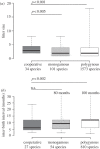Life histories and the evolution of cooperative breeding in mammals
- PMID: 22874752
- PMCID: PMC3427589
- DOI: 10.1098/rspb.2012.1433
Life histories and the evolution of cooperative breeding in mammals
Abstract
While the evolution of cooperative breeding systems (where non-breeding helpers participate in rearing young produced by dominant females) has been restricted to lineages with socially monogamous mating systems where coefficients of relatedness between group members are usually high, not all monogamous lineages have produced species with cooperative breeding systems, suggesting that other factors constrain the evolution of cooperative breeding. Previous studies have suggested that life-history parameters, including longevity, may constrain the evolution of cooperative breeding. Here, we show that transitions to cooperative breeding across the mammalian phylogeny have been restricted to lineages where females produce multiple offspring per birth. We find no support for effects of longevity or of other life-history parameters. We suggest that the evolution of cooperative breeding has been restricted to monogamous lineages where helpers have the potential to increase the reproductive output of breeders.
Figures


Similar articles
-
Cooperative breeding and monogamy in mammalian societies.Proc Biol Sci. 2012 Jun 7;279(1736):2151-6. doi: 10.1098/rspb.2011.2468. Epub 2012 Jan 25. Proc Biol Sci. 2012. PMID: 22279167 Free PMC article.
-
Helpers at the nest improve late-life offspring performance: evidence from a long-term study and a cross-foster experiment.PLoS One. 2012;7(4):e33167. doi: 10.1371/journal.pone.0033167. Epub 2012 Apr 4. PLoS One. 2012. PMID: 22496744 Free PMC article.
-
Breeders that receive help age more slowly in a cooperatively breeding bird.Nat Commun. 2019 Mar 21;10(1):1301. doi: 10.1038/s41467-019-09229-3. Nat Commun. 2019. PMID: 30899016 Free PMC article.
-
Breeding together: kin selection and mutualism in cooperative vertebrates.Science. 2002 Apr 5;296(5565):69-72. doi: 10.1126/science.296.5565.69. Science. 2002. PMID: 11935014 Review.
-
Structure and function in mammalian societies.Philos Trans R Soc Lond B Biol Sci. 2009 Nov 12;364(1533):3229-42. doi: 10.1098/rstb.2009.0120. Philos Trans R Soc Lond B Biol Sci. 2009. PMID: 19805430 Free PMC article. Review.
Cited by
-
Paternal care and litter size coevolution in mammals.Proc Biol Sci. 2016 Apr 27;283(1829):20160140. doi: 10.1098/rspb.2016.0140. Proc Biol Sci. 2016. PMID: 27097924 Free PMC article.
-
The expendable male hypothesis.Philos Trans R Soc Lond B Biol Sci. 2019 Sep 2;374(1780):20180080. doi: 10.1098/rstb.2018.0080. Epub 2019 Jul 15. Philos Trans R Soc Lond B Biol Sci. 2019. PMID: 31303164 Free PMC article.
-
Social interactions in a solitary carnivore.Curr Zool. 2017 Aug;63(4):357-362. doi: 10.1093/cz/zow080. Epub 2016 Jul 10. Curr Zool. 2017. PMID: 29491995 Free PMC article.
-
Hunter-Gatherer children's close-proximity networks: Similarities and differences with cooperative and communal breeding systems.Evol Hum Sci. 2024 Jan 31;6:e11. doi: 10.1017/ehs.2024.1. eCollection 2024. Evol Hum Sci. 2024. PMID: 38516373 Free PMC article.
-
Beyond promiscuity: mate-choice commitments in social breeding.Philos Trans R Soc Lond B Biol Sci. 2013 Jan 21;368(1613):20120050. doi: 10.1098/rstb.2012.0050. Print 2013 Mar 5. Philos Trans R Soc Lond B Biol Sci. 2013. PMID: 23339241 Free PMC article. Review.
References
-
- Solomon N. G., French J. A. 1997. Cooperative breeding in mammals. Cambridge, UK: Cambridge University Press
-
- Koenig W. D., Dickinson J. L. 2004. Ecology and evolution of cooperative breeding in birds. Cambridge, UK: Cambridge University Press
-
- Foster K. R. 2009. A defense of sociobiology. Cold Spring Harbor Symp. Quant. Biol. 74, 403–41810.1101/sqb.2009.74.041 (doi:10.1101/sqb.2009.74.041) - DOI - DOI - PubMed
-
- Bourke A. F. G. 2011. The validity and value of inclusive fitness theory. Proc. R. Soc. B 278, 3313–332010.1098/rspb.2011.1465 (doi:10.1098/rspb.2011.1465) - DOI - DOI - PMC - PubMed
-
- Cornwallis C. K., West S. A., Davis K. E., Griffin A. S. 2010. Promiscuity and the evolutionary transition to complex societies. Nature 466, 969–97210.1038/nature09335 (doi:10.1038/nature09335) - DOI - DOI - PubMed
Publication types
MeSH terms
LinkOut - more resources
Full Text Sources

